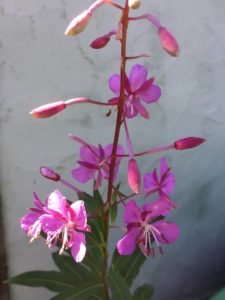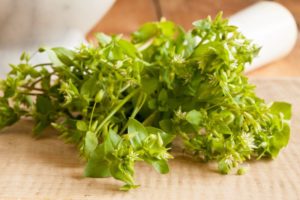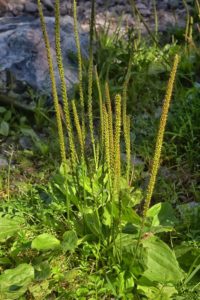
WEEDS FOR WELLNESS – DANDELION
 Finally the bright yellow flowers are brightening the landscape – a sure sign that spring is here to stay.
Finally the bright yellow flowers are brightening the landscape – a sure sign that spring is here to stay.
Hard to believe that herbalists have great appreciation for this marvelous creation of nature? We use flowers, buds, leaves and roots as food and medicine. My grand kids nibble on the flowers and young leaves.
Last year I made a crown out of Dandelion flowers for my then 4 year old grand daughter. She was wearing it proudly as we walked into Canadian Tire. With great joy I observed the reactions of customers especially when we were wandering around the Round-up shelf. So much fun!
Be creative and “brave” – eat flowers and young leaves, add both to salads, make a Dandelion flower cold infusion. decorate ice creams and cakes … and most of all, have fun and be grateful for the gift of this plant that most consider to be a pesky weed.
DANDELION – Taraxacum off. – Asteraceae famly
PARTS USED: Roots, stems, leaves and flowers
HARVEST TIME
Roots: Spring before flowering or fall after first frost
Leaves: Early spring, throughout summer (leaves increase in bitter taste with age)
Flowers: When in full bloom
NUTRITIONAL VALUE
Rich in minerals such as calcium, iron, copper, magnesium, manganese, phosphorus, potassium, selenium, silicon, and zinc. Vitamins A, B complex, C and D.
Carotenoids, fatty acids, flavenoids and phytosterols.
NOTE: The roots are exceptionally high in vitamin A
THERAPEUTIC ACTIONS
Leaf: Diuretic (high in potassium) – Choleretic (stimulates bile production by liver) – Aperient (mild laxative)
Root: Bitter digestive tonic; nutritive – Choleretic, cholagogue – Aperient, laxative – Anti-rheumatic, anit-inflammatory (animal studies)
Sap: Keratolytic (breaks down outer layer of skin)
INDICATIONS
Leaf: Water retention
Root: Inadequate bile production, gallstones, liver/gall bladder insufficiency, congestive jaundice, Dyspepsia, lack of appetite
Sap of stalks, roots, or leaves: Warts, cankers
FORM OF PREPARATION
Infusions (leaves; flowers) – Decoctions (root) – Tinctures – Vinegars (roots, leaves, flowers) – Infused Oils – Salves – Food (leaves, petals, young roots)
CONTRA-INDICATIONS
No reported toxicity; however some people experience sensitivity reactions
WEEDS FOR WELLNESS – A GUIDE TO YOUR BACKYARD PHARMACY FIREWEED
Epilobium/Chamerion Angustifolium
 The pale purple, pinkish flowers of Fireweed are lavishly decorating our landscape right now. You can watch bees swarming around the plants, they love the flowers. Fireweed is apparently the only plant in the world that has purple pollen. It is the first plant to grow after a fire, preparing the soil for other plants and trees to follow. Fireweed provides both food and medicine for us. Hippocrates said: “Let food be thy medicine and medicine be thy food.” How true this is.
The pale purple, pinkish flowers of Fireweed are lavishly decorating our landscape right now. You can watch bees swarming around the plants, they love the flowers. Fireweed is apparently the only plant in the world that has purple pollen. It is the first plant to grow after a fire, preparing the soil for other plants and trees to follow. Fireweed provides both food and medicine for us. Hippocrates said: “Let food be thy medicine and medicine be thy food.” How true this is.
The FLOWERS, UNOPENED BUDS and YOUNG LEAVES of Fireweed make a great addition to any salad, and of course, I add any of them to my Jungle Juice. The young shoots can be prepared like asparagus. A tea made from the LEAVES may simply be enjoyed as a beverage or used for medicinal purposes in cases of enlarged prostate (benign prostatic hyperplasia – BPH). Note: Some sources suggest that Fireweed tea has a slight laxative effect whereas others say it is being used for certain forms of diarrhea. Therefore, be your own judge and enjoy the tea in moderation until you know how it affects you – this, of course, holds true for anything you ingest or put on your skin.
 As mentioned in an earlier post, a SPIT POULTICE made from the leaves, just like Plantain, will provide great relief from insect bites – numbing the pain as well as reducing swelling and allergic reactions. I have heard from numerous people this year who have made use of this knowledge and were able to avoid hospital trips while watching the magic of the plant world unfold in front of their eyes. The gifts of nature are all around us. The poultice can also be used to minimize bruising and help draw slivers.
As mentioned in an earlier post, a SPIT POULTICE made from the leaves, just like Plantain, will provide great relief from insect bites – numbing the pain as well as reducing swelling and allergic reactions. I have heard from numerous people this year who have made use of this knowledge and were able to avoid hospital trips while watching the magic of the plant world unfold in front of their eyes. The gifts of nature are all around us. The poultice can also be used to minimize bruising and help draw slivers.
The FLOWERS, some sources include the leaves as well, provide effective relief for hemorrhoids. For this purpose, make an infused oil which can be used as is or made into suppositories. It is advisable to look at diet, lifestyle and liver function when dealing with hemorrhoids.
A decoction made from the WHOLE HERB, including the ROOT, has traditionally been used as an anti-spasmodic in the treatment of (whooping) cough and asthma. The preparation was allowed to cool before taken internally.
Fireweed can be considered a survival food with anti-inflammatory properties. It is relatively high in nutrients including vitamin C, beta-carotenes, calcium and magnesium. Always remember though, that the nutrient content (and flavour) of a plant varies greatly with the soil it is grown in.
RECIPE SUGGESTIONS
1. Add leaves, flowers and/or buds in any salad
2. Slightly steam young shoots until just tender. Melt butter, add lime juice, pour over Fireweed. Sprinkle with seeds/and or nuts on top (almonds, hemp hearts…)
Adjust proportions to your own liking. Remember, I consider myself a “free-flowing cook”. No recipe will ever turn out the same.
RESOURCE – QUESTION: Not sure how to prepare infusions, decoctions, infused oils etc? You find all these and many more preparations in my instructional DVD (over three hours of hands-on instructions): Herbal Pharmacy for Everyone – A Practical Guide to Creating Your Own Herbal Preparations. www.herbalinstructions.com. Subtitles in English, German, French and Spanish included as well as an appendix with all the recipes – just like a book.
WEEDS FOR WELLNESS – A GUIDE TO YOUR BACKYARD PHARMACY
CHICKWEED – Stellaris Media
 Chickweed is one of my favorite herbs. You can use all aerial parts of the plant. My husband has gotten into trouble more than once when he got rid of it from garden beds. Chickens and small birds enjoy feeding on Chickweed as well – probably the reason for its name. Chickweed is very nourishing, it contains many minerals and vitamins such as vitamin C, copper, iron, phosphorus and potassium.
Chickweed is one of my favorite herbs. You can use all aerial parts of the plant. My husband has gotten into trouble more than once when he got rid of it from garden beds. Chickens and small birds enjoy feeding on Chickweed as well – probably the reason for its name. Chickweed is very nourishing, it contains many minerals and vitamins such as vitamin C, copper, iron, phosphorus and potassium.
My preference is to use Chickweed raw in salads, added to smoothies and the Jungle Juice, and as a garnish on sandwiches and in wraps. The flavour is mild and as with many herbs the younger plants are preferable. Especially when using it raw for salads and toppings, the stems of more mature plants get stringy, so you may only want to us the (flowering) tops. Try mixing it into cream cheese or make a herbal butter by adding chives and chickweed and maybe a bit of flax oil.
You can also add Chickweed to soups and other cooked dishes. However, you don’t want to cook Chickweed for more than a few minutes; therefore I suggest you add it towards the end after any other vegetables and greens have their required tenderness.
Medicinally Chickweed is very soothing to the skin. I like to use it externally for skin conditions such as eczema and itchy skin. It also has a cooling effect. Apparently the herb is also used as a tea in natural weight loss programs; however, I do not have any personal experience with this application. Less well known is the fact that Chickweed helps to soothe stomach ulcers and other digestive ailments.
Have fun, be creative and I hope you will enjoy Chickweed as much as I do.
Green blessings,
Gudrun
WEEDS FOR WELLNESS – A GUIDE TO YOUR BACKYARD PHARMACY
PLANTAIN – PLANTAGO MAJOR
 Plantain is one of the most versatile herbal medicines. We can use the leaves, seeds and roots but I will focus on the use of the leaves in the post. Most of you will have come across it. Most commonly around here we find broad-leaved Plantain (Plantago major). The plant grows along waysides, in gardens, lawns, pastures, meadows and cultivated fields. The leaves are very broad ovate and surround the stem in a basal rosette.
Plantain is one of the most versatile herbal medicines. We can use the leaves, seeds and roots but I will focus on the use of the leaves in the post. Most of you will have come across it. Most commonly around here we find broad-leaved Plantain (Plantago major). The plant grows along waysides, in gardens, lawns, pastures, meadows and cultivated fields. The leaves are very broad ovate and surround the stem in a basal rosette.
Plantain, just like so many other so-called weeds, is rich with nutrients including vitamins A, C, K, zinc, iron, calcium, magnesium, potassium, phosphorus and silicic acid. Remember that the nutritional value of any (edible) plant depends greatly on the soil it is growing in. Silica promotes tissue repair, in this case specifically in the lungs. Zinc enhances immune system function. Plantain also contains mucilage. Mucilage has a soothing effect on any tissue.
Internally Plantain is primarily used for any respiratory tract challenges, it restores the lungs and helps to expel mucous. It is helpful in conditions such as coughs including nervous cough, bronchitis, lung infections, allergic asthma and any other congestion incl. sinus and ear infections. I always have a jar of dried leaves on hand in the winter for my grand children. As a tea it can also be useful in cases of urinary tract infections or simple irritation.
Internally and externally it is a great wound healer for sores, cuts, scratches, dog bites, ulcers and burns. Applied as a poultice it provides instant relief from insect bites. Chew on a few leaves to get the juice from the plant flowing and apply directly to the irritated area(s). It is amazing how good this feels.
Plantain has many more usages but these are the most common ones.
As food you can add some leaves to the Jungle Juice or salad, use as spinach (cook only for a few minutes) or as a potherb. The younger leaves are preferable to older ones. And of course, you can make an herbal tea from the leaves as well.
I highly recommend that you get out there, harvest this miracle herb and add it to some of your dishes. But not only this, make sure you dry some for use in fall and winter in case a nasty cough gets hold of you.
Happy herballing and green blessings,
Gudrun



Follow Us!